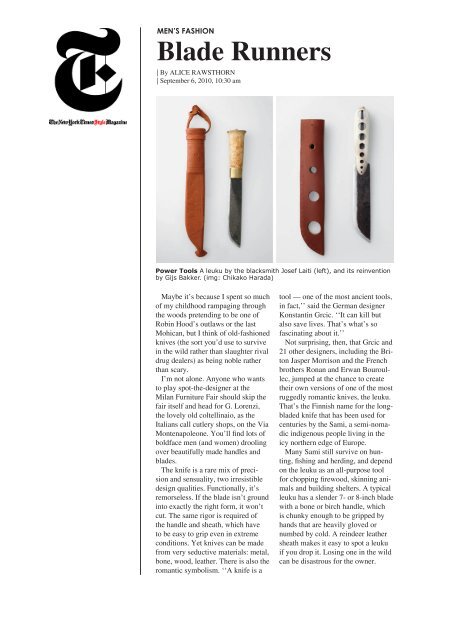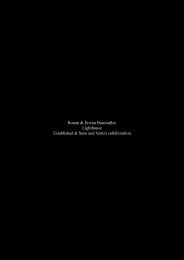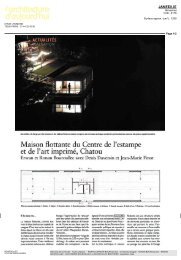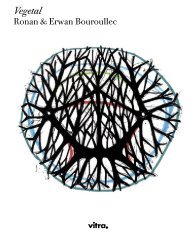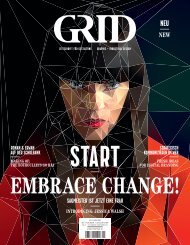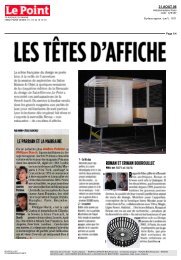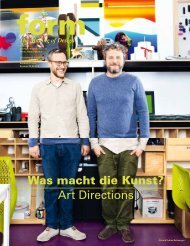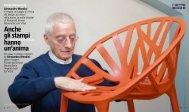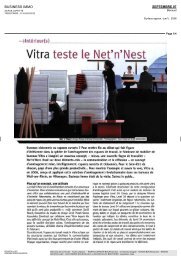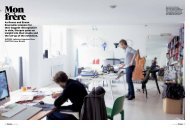Blade Runners - Ronan et Erwan Bouroullec
Blade Runners - Ronan et Erwan Bouroullec
Blade Runners - Ronan et Erwan Bouroullec
You also want an ePaper? Increase the reach of your titles
YUMPU automatically turns print PDFs into web optimized ePapers that Google loves.
MEN’S FASHION<br />
<strong>Blade</strong> <strong>Runners</strong><br />
| By ALICE RAWSTHORN<br />
| September 6, 2010, 10:30 am<br />
Power Tools A leuku by the blacksmith Josef Laiti (left), and its reinvention<br />
by Gijs Bakker. (img: Chikako Harada)<br />
Maybe it’s because I spent so much<br />
of my childhood rampaging through<br />
the woods pr<strong>et</strong>ending to be one of<br />
Robin Hood’s outlaws or the last<br />
Mohican, but I think of old-fashioned<br />
knives (the sort you’d use to survive<br />
in the wild rather than slaughter rival<br />
drug dealers) as being noble rather<br />
than scary.<br />
I’m not alone. Anyone who wants<br />
to play spot-the-designer at the<br />
Milan Furniture Fair should skip the<br />
fair itself and head for G. Lorenzi,<br />
the lovely old coltellinaio, as the<br />
Italians call cutlery shops, on the Via<br />
Montenapoleone. You’ll find lots of<br />
boldface men (and women) drooling<br />
over beautifully made handles and<br />
blades.<br />
The knife is a rare mix of precision<br />
and sensuality, two irresistible<br />
design qualities. Functionally, it’s<br />
remorseless. If the blade isn’t ground<br />
into exactly the right form, it won’t<br />
cut. The same rigor is required of<br />
the handle and sheath, which have<br />
to be easy to grip even in extreme<br />
conditions. Y<strong>et</strong> knives can be made<br />
from very seductive materials: m<strong>et</strong>al,<br />
bone, wood, leather. There is also the<br />
romantic symbolism. ‘‘A knife is a<br />
tool — one of the most ancient tools,<br />
in fact,’’ said the German designer<br />
Konstantin Grcic. ‘‘It can kill but<br />
also save lives. That’s what’s so<br />
fascinating about it.’’<br />
Not surprising, then, that Grcic and<br />
21 other designers, including the Briton<br />
Jasper Morrison and the French<br />
brothers <strong>Ronan</strong> and <strong>Erwan</strong> <strong>Bouroullec</strong>,<br />
jumped at the chance to create<br />
their own versions of one of the most<br />
ruggedly romantic knives, the leuku.<br />
That’s the Finnish name for the longbladed<br />
knife that has been used for<br />
centuries by the Sami, a semi-nomadic<br />
indigenous people living in the<br />
icy northern edge of Europe.<br />
Many Sami still survive on hunting,<br />
fishing and herding, and depend<br />
on the leuku as an all-purpose tool<br />
for chopping firewood, skinning animals<br />
and building shelters. A typical<br />
leuku has a slender 7- or 8-inch blade<br />
with a bone or birch handle, which<br />
is chunky enough to be gripped by<br />
hands that are heavily gloved or<br />
numbed by cold. A reindeer leather<br />
sheath makes it easy to spot a leuku<br />
if you drop it. Losing one in the wild<br />
can be disastrous for the owner.
More leuku reinventions by Jasper Morrison (left), and <strong>Ronan</strong> and <strong>Erwan</strong><br />
<strong>Bouroullec</strong>. (img: Chikako Harada)<br />
Making such a robust tool requires<br />
considerable skill in the traditional<br />
techniques that Sami craftsmen have<br />
honed for centuries. Those skills are<br />
now dying, which is why the Finnish<br />
designer Simo Heikkila is trying<br />
to revive them. ‘‘The leuku is a<br />
beautiful and functional object, pure<br />
in shape, well balanced and simply<br />
composed,’’ he said. ‘‘Locally developed<br />
objects like this are vanishing<br />
all over the world.’’<br />
He began by organizing a workshop<br />
for students at the forge of one of<br />
Finland’s great leuku makers, the<br />
blacksmith Josef Laiti. The next step<br />
was to invite international designers<br />
to reinterpr<strong>et</strong> the original 7-inch<br />
knife. The results were exhibited in<br />
Finland last year and will be shown<br />
again at the Saint-Étienne Design<br />
Biennial in France this fall, when a<br />
book on the project is to be published.<br />
Most of the designers remained<br />
faithful to the original leuku while<br />
interpr<strong>et</strong>ing it in their own way. ‘‘It<br />
didn’t seem right to try and redesign<br />
som<strong>et</strong>hing which has its shape from<br />
hundreds of years of trial and error,’’<br />
said Morrison, who is known for<br />
his subtly minimalist design style.<br />
‘‘I simply tried to imagine what a<br />
beautiful leuku would look like, refining<br />
the blade and handle shape, and<br />
giving it a sheath with a simple way<br />
of attaching it.’’<br />
The <strong>Bouroullec</strong> brothers showed<br />
similar restraint, but used bone<br />
— ‘‘the most sensual of the original<br />
leuku materials,’’ as <strong>Ronan</strong> <strong>Bouroullec</strong><br />
put it — for both the handle and<br />
the sheath.<br />
By contrast, Grcic, who always starts<br />
the design process by analyzing<br />
how the object will be used, looked<br />
for ways of improving the leuku<br />
functionally, and he found a flaw. ‘‘It<br />
seemed difficult to pull the original<br />
knife from its sheath,’’ he said.<br />
‘‘So I added a lash on the end of the<br />
handle. Your finger can go through a<br />
hole in the lash to pull out the knife<br />
in an emergency.’’<br />
By puncturing both the knife’s handle<br />
and sheath with a series of holes,<br />
revealing the part of the blade that’s<br />
usually hidden beneath the handle,<br />
the Dutch designer Gijs Bakker<br />
hoped to highlight the craftsmanship<br />
of the knife. ‘‘The hidden part shows<br />
off the technique, but because it’s<br />
considered to be ugly and, of course,<br />
can’t be held in the hand, it’s always<br />
covered,’’ he said. ‘‘My design is a<br />
sort of homage to the blacksmith.’’


